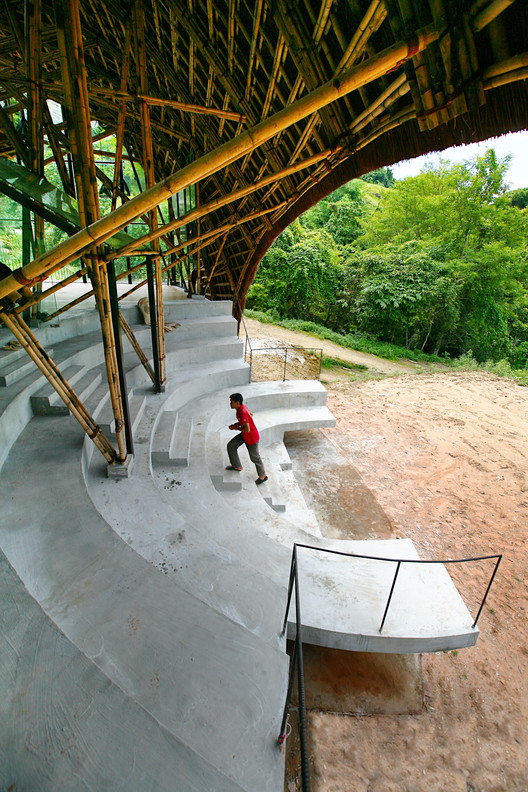The Memorial Hall of Israel’s Fallen at Mount Herzl Kimmel Eshkolot Architects
2018-03-08 04:00
© Amit Geron
阿米特·杰龙(Amit Geron)


架构师提供的文本描述。Kimmel Eshkolot建筑师“以色列阵亡将士纪念馆”坐落在以色列国家公墓Herzl山,也是以色列最重要的遗址之一。纪念馆是一个个人和集体的建筑,用来纪念以色列阵亡的士兵,其阵阵呈凹凸不平的漏斗状的砖块,打开大厅通向天空,用自然光淹没了虚空。
Text description provided by the architects. Kimmel Eshkolot Architects “Memorial Hall of Israel's Fallen” sits at Mount Herzl, Israel's National Cemetery, and one of the most important sites in the country. The Memorial is a personal and collective structure that commemorates Israel's fallen soldiers with an undulating funnel-shaped formation of bricks that opens the hall to the sky, flooding the void with natural light.
© Amit Geron
阿米特·杰龙(Amit Geron)


2006年,由以色列国防部家庭、纪念和遗产司委托,这座250米长的连续“人名墙”缠绕在中央雕塑砖结构周围,情感影响深远。这面螺旋墙由23000多块混凝土砖组成,每个砖上都刻着一名阵亡士兵的名字和他们去世的日期,每逢周年纪念都会被白炽灯照亮。纪念馆的中央灯管漏斗位于管状结构内。
Commissioned by the Department of Families, Commemoration and Heritage at Israel's Ministry of Defense in 2006, the emotionally impactful memorial winds around a 250-meter long continuous "Wall of Names" that wraps around the central sculptural brick structure. This spiraling wall is comprised of more than 23,000 concrete bricks each individually engraved with the name of a fallen soldier and their date of decease, which becomes illuminated by incandescent lights on each respective anniversary. Inside the tubular structure sits the memorial's central light funnel.
Floor Plan


为了给纪念馆创造一个宁静的空间,纪念馆的设计首先是一个室内工程。挖掘这座山,使大厅里有充足的日光,是Kimmel Eshkolot的主要工作重点,地形的重建是次要的。以色列阵亡将士纪念馆的目的是要从外观上卸下气势,并与邻近墓地的质地相呼应。在内部,通过Oculus进入的光线通过漏斗被微妙地过滤。通过这“石花边”,灯光闪烁在大厅的参数沿着结构的墙的名字。
With the intention of creating a serene space for the hall, the design of the memorial is firstly a project of an interior. Excavating the mountain to allow for abundance of daylight in the hall was a primary focus of Kimmel Eshkolot, with the reconstruction of the terrain being secondary. The Memorial Hall of Israel's Fallen is intended to be unimposing from the exterior, and to echo the texture of the adjacent cemetery. In the interior, the light that enters through the oculus is subtly filtered through the funnel. Through this "stone lace," light flickers in the parameter of the hall along the structure's Wall of Names.
© Amit Geron
阿米特·杰龙(Amit Geron)




© Amit Geron
阿米特·杰龙(Amit Geron)


在苏黎世ETH建造了几个1:1的模型来测试漏斗的构造。最初的策略是将砖块粘在一起,目的是尽量减少元素之间的重叠。这种方法在结构上是可行的,但由于不符合当地的建筑条例而被忽视。通过这些测试,并与阿克斯坦工业公司和默卡瓦,Kimmel Eshkolot开发了独特的混凝土砖与钢芯,是一起在预先切割接头。通过对活载荷和死载荷的进一步计算,可以使铝制砖减轻重量。
Several 1:1 mockups were constructed at ETH Zurich to test the construction of the funnel. The initial strategy was based on glueing the bricks to one another, aiming at a minimal overlap between the elements. This method was proven to be structurally viable, but was neglected because it could not meet the local building regulations. With these tests, and together with Ackerstein Industries and Merkava, Kimmel Eshkolot developed unique concrete bricks with steel cores that were screwed together at the pre-cut joints. Further calculations of the live loads and the dead loads led to making the bricks from aluminum to reduce weight.
© Amit Geron
阿米特·杰龙(Amit Geron)


位于历史悠久的赫兹尔山之上,这是犹太复国主义的同名创始人和以色列国家公墓的安息之地,Kimmel Eshkolot建筑师的结构尊重它所涵盖的地点的孤立和安静性质。在它的外部,结构遵循着山的地形,曲线的耶路撒冷石,统一的“敷料”的圣城。游客可以直接穿过纪念馆走向赫兹尔山公墓,也可以沿着一堵砖墙走下一系列楼梯,到达大厅的入口处,而墙的内部则是人名之墙。
Set atop the historic Mount Herzl, the resting place of the namesake founder of Zionism and the site of Israel's national cemetery, Kimmel Eshkolot Architects' structure pays respect to the isolation and quiet nature of the site on which it encompasses. Within its exterior, the structure follows the topography of the mountain with curves of light Jerusalem stone, the uniform "dressing" of the Holy City. Visitors can walk directly through the memorial hall towards Mount Herzl Cemetery, or walk down a series of stairs to the entrance of the hall, along a brick wall which in the interior becomes the Wall of Names.
© Amit Geron
阿米特·杰龙(Amit Geron)






















































































Architects Kimmel Eshkolot Architects
Location Jerusalem, Israel
Architect in Charge Etan Kimmel and Limor Amrani
Area 5000.0 m2
Project Year 2018
Photographs Amit Geron
Category Memorial Center
Manufacturers Loading...
























